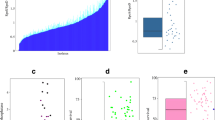Abstract
A prolonged incubation of Escherichia, Salmonella or Pseudomonas at 48°C with nalidixic acid selected mutants (T48) able to grow at 48°C. A prolonged incubation at 54°C of the T48 mutants selected mutants (T54) able to grow at 54°C. These mutants were susceptible to the same bacteriophages as the original mesophilic strains. Auxotrophic phenotypes of Escherichia coli and Salmonella typhimurium mesophilic parents were demonstrated by these mutants if they were cultivated on minimal agar with cellobiose at 48°C or 54°C or on a minimal agar with glucose at 37°C. The T48 alleles mapped in the gyrA region of E. coli or S. typhimurium chromosome. In S. typhimurium the T54 alleles, which permit growth at 54°C, were shown by cotransductional analysis to be linked to gyrA.
Similar content being viewed by others
References
Barnes CA, Johnson GC, Singer RA (1990) Thermotolerance is independent of induction of the full spectrum of heat shock proteins and of cell cycle blockage in the yeast. J Bacteriol 172:4352–4358
Dorman CJ, Bhriain NN, Higgins CF (1990) DNA supercoiling and environmental regulation of virulence gene expression in Shigella flexneri. Nature 344:789–795
Drilca K (1984) Biology of bacteriol deoxyribonucleic acid topoisomerases. Microbiol Rev 48:273–289
Droffner ML, Yamamoto N (1985) Isolation of thermophilic mutants of B. subtilis and B. pumilus and transformation of the thermophilic trait to mesophilic strains. J Gen Microbiol 131:2791–2794
Forterre P, Nadal M, Elie C, Mirambeau G, Jaxel C, Duguet M (1986) Mechanisms of DNA synthesis and topoisomerization in Archaebacteria-Reverse gyration in vivo and in vitro. Syst Appl Microbiol 7:67–71
Friedman MS, Droffner ML, Yamamoto N (1991) Thermotolerant nalidixic acid-resistant mutants of Escherichia coli Curr Microbiol (in press)
Galan JE, Curtiss III P (1990) Expression of Salmonella typhimurium genes required for invasion is regulated by changes in DNA suprocoiling. Infect Immunol 58:1879–1885
Goransson M, Sonsen B, Nilsson P, Dagberg B, Forsman K, Emanuelsson K, Uhlin BE (1990) Translational silencing and thermoregulation of gene expression in Escherichia coli. Nature 344:682–685
Hall BG, Betts PW (1987) Cryptic genes of cellobiose utilization in natural isolates of Escherichia coli. Genetics 115:431–439
Johnson EJ (1979) Thermophile genetics and the genetic determinants of thermophily. In: Shilo M de (ed) Strategies of microbial life in extreme environments. VCH, Weinheim New York Cambridge, pp 471–487
Kikuchi A, Asai K (1984) Reverse gyrase-A topoisomerase which introduces positive superhelical coils into DNA. Nature 309:667–681
Mackey BM, Derrick CM (1986) Elevation of the heat resistance of Salmonella typhimurium by sublethal heat shock. J Appl Bacteriol 61:389–393
Parker LL, Hall BG (1988) A fourth Escherichia coli gene system with the potential to evolve β-Glucoside utilization. Genet 119:485–490
Schaefler S, Malmey A (1969) Taxonomic investigations on expressed and cryptic phospho-β-glucosidases in Enterobacteriaceae. J Bacteriol 99:422–433
VanBogelen RA, Kelley PM, Neidhardt FC (1987a) Differential induction of heat shock. SOS, and oxidation stress regulons and accumulation of nucleotides in Escherichia coli. J Bacteriol 169:26–32
VanBogelen RA, Acton MA, Neidhardt FC (1987b) Induction of the heat shock regulon does not produce thermotolerance in Escherichia coli. Genes Dey 1:525–531
Yamamori T, Yura V (1982) Genetic control of heat-shock protein synthesis and its bearing on growth and thermal resistance in Escherichia coli K12. Proc Natl Acad Sci USA 79:860–864
Yamamoto N, Droffner ML (1985) Mechanisms determining aerobic or anaerobic growth in the facultative anaerobe Salmonella typhimurium. Proc Natl Acad Sci USA 82:2077–2081
Yamamoto N, Droffner ML (1988) Anaerobic expression of the gyrA gene as demonstrated by β-galactosidase activity in gyrA: Mu-lac fusion derivative of E. coli. FEMS Microbiol Lett 56:209–214
Yamamoto N, Droffner ML, Yamamoto S (1987) Conditional mutations of Salmonella typhimurium that are suppressed by anaerobic or aerobic environments. FEMS Microbiol Lett 42:249–252
Yoshizawa Y, Yamamoto N (1989) Isolation and characterization of strict aerobic mutants of Escherichia coli. Microbiol Immunol 33:449–457
Author information
Authors and Affiliations
Rights and permissions
About this article
Cite this article
Droffner, M.L., Yamamoto, N. Prolonged environmental stress via a two step process selects mutants of Escherichia, Salmonella and Pseudomonas that grow at 54°C. Arch. Microbiol. 156, 307–311 (1991). https://doi.org/10.1007/BF00263003
Received:
Accepted:
Issue Date:
DOI: https://doi.org/10.1007/BF00263003




